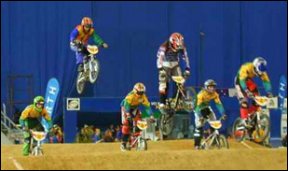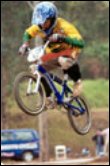Enjoy Your BMX - But Always Wear Your Helmet
From a safety point, the most important rule is: always wear a helmet The helmet must be full face ≠ much like a motor bike helmet and not like a standard cycle helmet, which does not provide sufficient protection. It is also essential to wear long pants and a long sleeve shirt. Gloves, while not compulsory, are highly recommended. Riders may also wear the body armour typical of moto cross participants, but not many do this. The bike itself must be equipped with protective pads across the cross bar, top of the handlebars and the 'goose neck' ≠ the area where the handle bar joins the frame. The bike must be fitted only with a rear brake and no front brake. It is important to note the bike does not have gears and runs with a front sprocket of about 46 teeth and rear sprocket of approximately 16 teeth. These ratios may be adjusted to suit the rider and the track. A BMX racing bike must not have any axel pegs (metal protrusions) that could injure another rider. According to Mr Greg Till, vice-president of the South African Cycling Federation, riders are encouraged to ride only on tracks and not on public roads. The track is the domain of the BMX rider and each track is planned in such a way as to challenge ridersí skills and provide excitement. A race meeting is held once a month at each of the three venues. "Riders of the same age and skill are given an opportunity to compete against one another. Riders may start at the age of four. We currently have riders who are fast approaching 50. It is a sport for the entire family. Those who don't race make great supporters and the excitement generated by the races certainly provides everyone with great entertainment," said Mr Till.
"There are a variety of obstacles with names such as rollers, doubles, table tops and rhythm sections. These vary in size from a few centimetres to a few meters. Because of the speed of the bikes, the turns are embanked and go by the name of berms," said Mr Till. On a typical race day a rider would race three qualifiers (Moto's) and
the best eight in that age category qualify Anyone wishing to find out more, can visit the official web site of BMX in South Africa, www.bmxsa.co.za As a discipline in cycling, BMX in South Africa is under the ultimate control of the South African Cycling Federation.
|
 MX
racing is a popular sport in South Africa. It has riders as young as four
and as old as those nearing 50. In KwaZulu-Natal, events are held on
prepared race- tracks in Pietermaritzburg, Pinetown (Lahee Park) and
Queensburgh.
MX
racing is a popular sport in South Africa. It has riders as young as four
and as old as those nearing 50. In KwaZulu-Natal, events are held on
prepared race- tracks in Pietermaritzburg, Pinetown (Lahee Park) and
Queensburgh. Each
race has a maximum of eight riders, categorised by age and ability. This
ensures that new riders donít compete against seasoned professionals. The
raceís duration is approximately 40 seconds and is a full sprint.
Competitors line up behind a metal start gate that is either manually or
electronically released.
Each
race has a maximum of eight riders, categorised by age and ability. This
ensures that new riders donít compete against seasoned professionals. The
raceís duration is approximately 40 seconds and is a full sprint.
Competitors line up behind a metal start gate that is either manually or
electronically released.